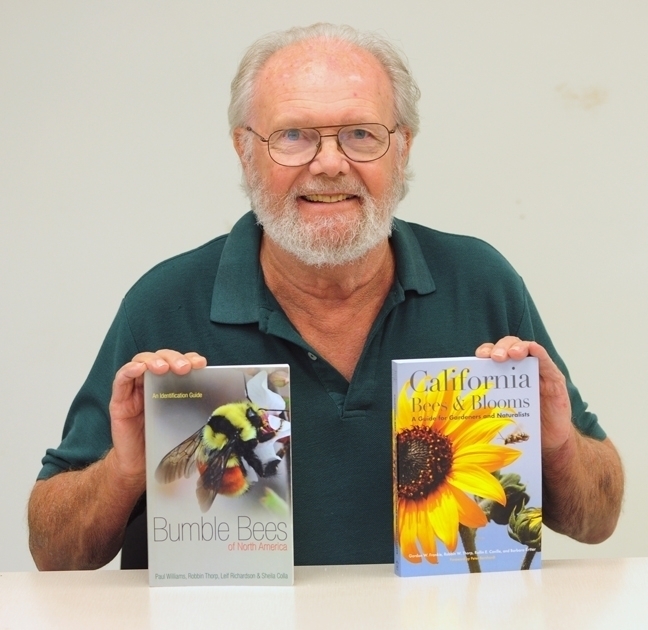
Well, weather permitting, you can begin searching for the first bumble bee of the year in the two-county area of Yolo and Solano. If you photograph it and you are judged the winner, a prize awaits you--in addition to bragging rights.
The third annual Robbin Thorp Memorial First-Bumble Bee-of-the-Year Contest will begin at 12:01, Jan. 1. The first person to photograph a bumble bee in the two-county area and email it to the sponsor, the Bohart Museum of Entomology, will receive a coffee cup designed with the endangered Franklin's bumble bee, the bee that Thorp monitored on the California-Oregon border for decades.
Contest coordinator Lynn Kimsey, director of the Bohart Museum and a UC Davis distinguished professor of entomology, said the image must be taken in the wild and emailed to bmuseum@ucdavis.edu, with the time, date and place.
The contest memorializes Professor Thorp (1933-2019), a global authority on bees and a UC Davis distinguished emeritus professor of entomology, who died June 7, 2019 at age 85. A 30-year member of the UC Davis faculty, he retired in 1994 but continued working until several weeks before his death. Every year he looked forward to seeing the first bumble bee in the area.
The black-tailed bumble bee, Bombus melanopygus, is usually the first bumble bee to emerge in this area, Thorp used to say. It forages on manzanitas, wild lilacs, wild buckwheats, lupines, penstemons, clovers, and sages, among others.
Two scientists shared the 2022 prize: UC Davis doctoral candidate Maureen Page of the Neal Williams lab, UC Davis Department of Entomology and Nematology, and horticulturist Ellen Zagory, retired director of public horticulture for the UC Davis Arboretum and Public Garden. They each photographed a bumble bee foraging on manzanita (Arctostaphylos) in the 100-acre Arboretum at 2:30 p.m., Saturday, Jan. 1.
Page photographed a black-tailed bumble bee, B. melanopygus, while Zagory captured an image of the yellow-faced bumble bee, B. vosnesenskii.
Fittingly, they both knew and worked with Thorp, a tireless advocate of pollinator species protection and conservation and the co-author of Bumble Bees of North America: An Identification Guide (Princeton University, 2014) and California Bees and Blooms: A Guide for Gardeners and Naturalists (Heyday, 2014).
This marked the second consecutive win for a member of the Williams lab. Postdoctoral researcher Charlie Casey Nicholson of the Williams lab and the Elina Lastro Niño lab, won the 2021 contest by photographing a Bombus melanopygus at 3:10 p.m., Jan. 14 in a manzanita patch in the Arboretum.
Both Page and Nicholson are alumni of The Bee Course, which Thorp co-taught from 2002-2018. Page completed the course in 2018, and Nicholson in 2015. The nine-day intensive workshop, geared for conservation biologists and pollination ecologists and considered the world's premiere native bee biology and taxonomic course, takes place annually in Portal, Ariz., at the Southwestern Research Station, part of the American Museum of Natural History, N.Y.
In July 2016, Page participated in a "Bumble Bee Blitz" organized by Thorp and the U. S. Fish and Wildlife Service on Mt. Ashland, where, she said, "we searched for Bombus franklini and Bombus occidentalis--two very rare west coast bee species. We unfortunately did not find B. franklini, which is now recognized as an endangered species under the Endangered Species Act.”
The prized coffee cup features an image of the bee specimen, photographed by Bohart scientist Brennen Dyer, now collections manager, and designed by UC Davis doctoral alumnus Fran Keller, a professor at Folsom Lake College. Previous winners are ineligible to win the prize.
Origins of the Contest. The contest actually originated in 2012 as a little rivalry between the late Professor Thorp and his "posse"--three of his bumble bee aficionados: Allan Jones and Gary Zamzow of Yolo County and yours truly of Solano County.
The Davis folks (Yolo County posse) looked for them in the manzanita bushes in the UC Davis Arboretum and Public Garden. Me? As the sole member of the Solano County posse, I headed over to Benicia to the marina and to the Benicia Capitol State Historic Park grounds. I always see them in December and/or January foraging near the marina on rosemary, and on oxalis, rosemary and jade on or near the state capitol grounds. And once on a rose in downtown Benicia.
In 2017, Jones found both a female and male in the Arboretum. At 2:02 on Jan. 27 to be exact. "After finding and photographing two males just east of the Arboretum's redwood grove, he spotted and photographed a female just west of it," we wrote on our Bug Squad blog.
"Surprising to see males this early in the season," Thorp told us. "Unusual to see males before any workers are on site. Could be from a gyne that overwintered but was not mated before she went into hibernation; or maybe the sperm she received were not viable; or maybe she was unable to release sperm from her spermatheca to some eggs as they passed through her reproductive tract."
"At any rate," the professor told Jones, "you got two firsts for the season at one time."
"I'd pat myself on the back if I were more flexible," Jones replied.
Pats are good. So is the prized coffee cup that awaits the 2023 winner.
Attached Images:
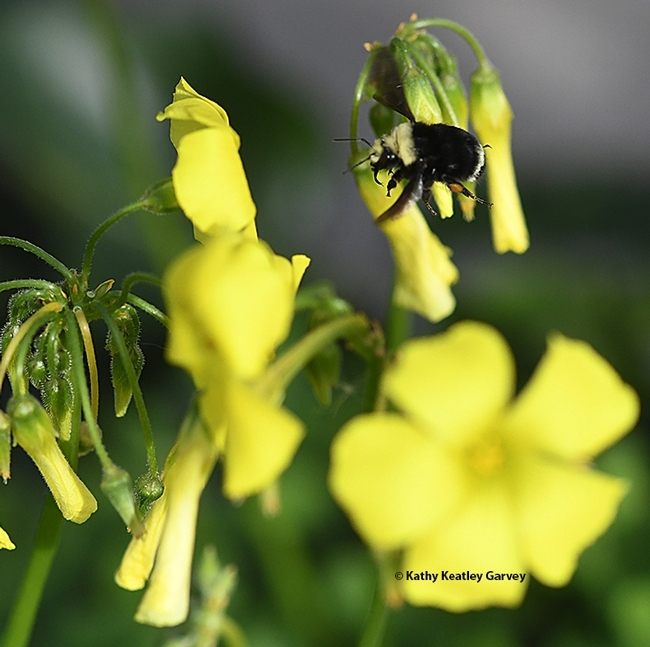
A yellow-faced bumble bee, Bombus vosenenskii, foraging on oxalis near the Benicia State Capitol grounds on Jan. 13, 2021. (Photo by Kathy Keatley Garvey)
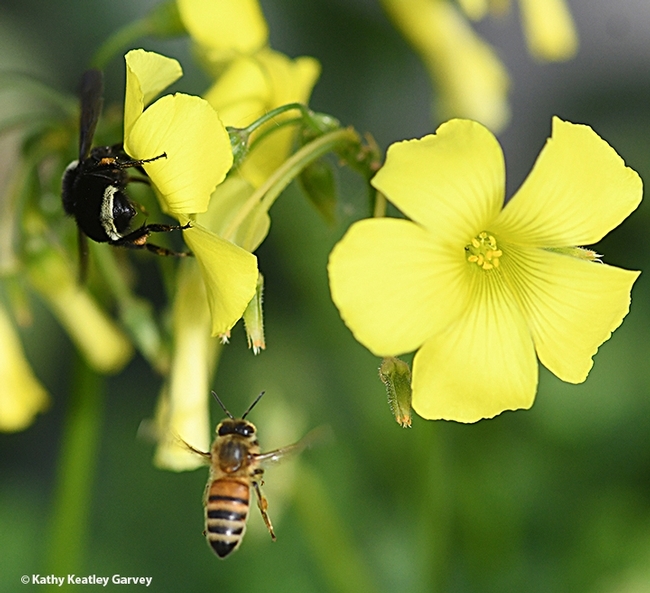
A honey bee and a yellow-faced bumble bee, Bombus vosenenskii, foraging on oxalis near the Benicia State Capitol grounds on Jan. 13, 2021. (Photo by Kathy Keatley Garvey)
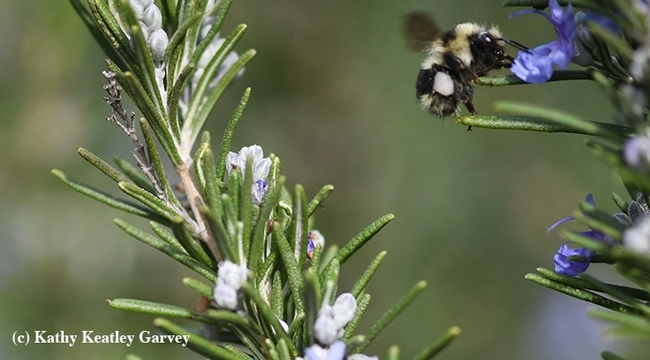
The black-tailed bumble bee, Bombus melanopygus, foraging on rosemary on Jan. 25, 2020 on the grounds of the Benicia Capitol State Historic Park. (Photo by Kathy Keatley Garvey)
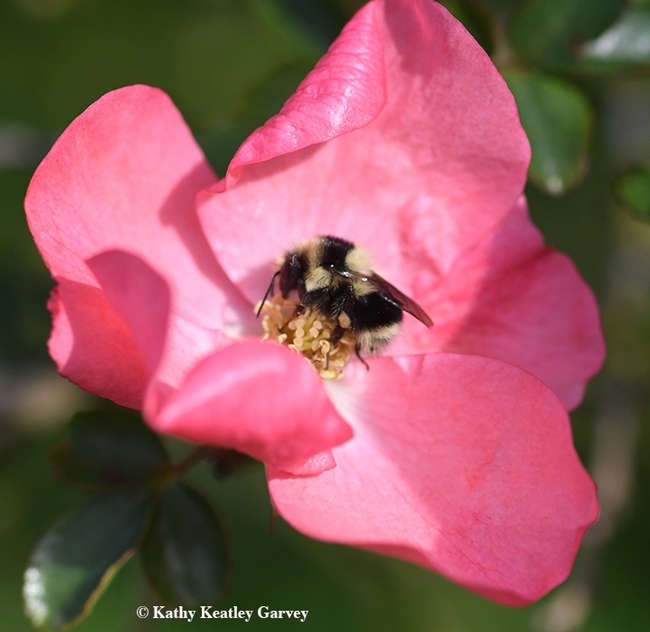
The black-tailed bumble bee, Bombus melanopygus, foraging on a rose on Jan. 25, 2020 in downtown Benicia. (Photo by Kathy Keatley Garvey)